|
Kylver Stone
The Kylver stone, listed in the Rundata catalog as runic inscription G 88, is a Swedish runestone which dates from about 400 AD. It is notable for its listing of each of the runes in the Elder Futhark. Description The Kylver stone was found during the excavation of a cemetery near a farm at Kylver, Stånga, Gotland in 1903. The stone was a flat limestone rock used to seal a grave and the runic inscription was written on the underside, and could therefore not be read from above. The dating of the stone from 400 CE is based upon the archeological dating of the graves. The Kylver stone was removed from Gotland and brought to the Swedish Museum of National Antiquities in Stockholm where it is on display . The fact that the inscription was on the inside of a cover to a grave has resulted in speculation that it represented a use of the Elder Futhark to pacify the dead man in some manner. However, it has been pointed out that there is nothing in the inscription to support this. In add ... [...More Info...] [...Related Items...] OR: [Wikipedia] [Google] [Baidu] |
Wynn
Wynn or wyn (; also spelled wen, ƿynn, and ƿen) is a letter of the Old English alphabet, where it is used to represent the sound . History The letter "W" While the earliest Old English texts represent this phoneme with the digraph , scribes soon borrowed the rune ''wynn'' for this purpose. It remained a standard letter throughout the Anglo-Saxon era, eventually falling out of use (perhaps under the influence of French orthography) during the Middle English period, circa 1300. It was replaced with once again, from which the modern developed. Meaning The denotation of the rune is "joy, bliss" known from the Anglo-Saxon Rune Poems: Miscellaneous It is not continued in the Younger Futhark, but in the Gothic alphabet the letter ''w'' is called , allowing a Proto-Germanic reconstruction of the rune's name as ''*wunjô'' "joy". It is one of the two runes (along with þ) to have been borrowed into the English alphabet (or any extension of the Latin alphabet) ... [...More Info...] [...Related Items...] OR: [Wikipedia] [Google] [Baidu] |
Swedish National Heritage Board
The Swedish National Heritage Board ( sv, Riksantikvarieämbetet; RAÄ) is a Swedish government agency responsible for World Heritage Sites and other national heritage monuments and historical environments. It is governed by the Ministry of Culture. The goals of the agency are to encourage the preservation and protection of historic environments and to promote the respect for and knowledge of historic environments. In order to do this, it tries to ensure that Swedish heritage is accessible to all citizens, to spread information about that heritage, and to "empower heritage as a force in the evolution of a democratic, sustainable society". History 17th and 18th century The National Heritage Board was founded in 1630. On the 20May that year, Johannes Bureus who was a prominent rune researcher and King Gustavus Adolphus' private teacher, was appointed the first ''riksantikvarien'' ("National Antiquarian"). Bureus' teachings had made the king interested in ancient monuments an ... [...More Info...] [...Related Items...] OR: [Wikipedia] [Google] [Baidu] |
Vadstena Bracteate
The Vadstena bracteate (Rundata Ög 178) is a gold C-bracteate found in the earth at Vadstena, Sweden, in 1774.''Nordisk Familjebok'', Owl Edition, pp. 262-26/ref> Along with the bracteate was a gold ring and a piece of gold sheet: all were nearly melted down by a goldsmith who was stopped by a local clergyman. The bracteate was stolen in 1938 from the Swedish Museum of National Antiquities and has not yet been found. The bracteate is believed to have been made about AD 500. In the middle of the bracteate is a four-legged animal with a man's head above it, and in front of this a bird separated from the other images by a line. This image is commonly associated with the Norse god Odin in bracteate iconography. The bracteate is most famous for containing a full listing of the Elder Futhark runic alphabet. The runes in the futhark are divided by dots into three groups of eight runes which are commonly called an ætt. The entire inscription reads: :tuwatuwa; fuþarkgw; hnijïpzs; tb ... [...More Info...] [...Related Items...] OR: [Wikipedia] [Google] [Baidu] |
Runic Magic
There is some evidence that, in addition to being a writing system, runes historically served purposes of magic. This is the case from the earliest epigraphic evidence of the Roman to the Germanic Iron Age, with non-linguistic inscriptions and the '' alu'' word. An ''erilaz'' appears to have been a person versed in runes, including their magic applications. In medieval sources, notably the Poetic Edda, the ''Sigrdrífumál'' mentions "victory runes" to be carved on a sword, "some on the grasp and some on the inlay, and name Tyr twice." In the early modern period and modern history, related folklore and superstition is recorded in the form of the Icelandic magical staves. In the early 20th century, Germanic mysticism coined new forms of "runic magic", some of which were continued or developed further by contemporary adherents of Germanic Neopaganism. Modern systems of runic divination are based on Hermeticism, classical Occultism, and the I Ching. Historical evidence Tacitus H ... [...More Info...] [...Related Items...] OR: [Wikipedia] [Google] [Baidu] |



